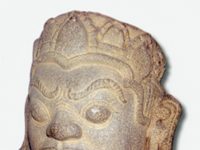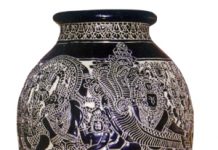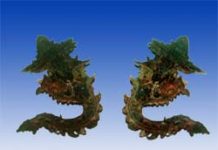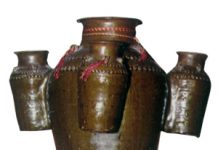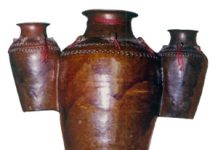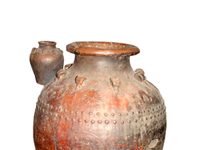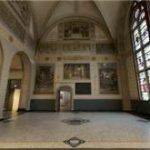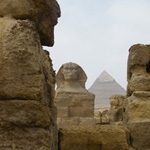| Together with inventory work, maintenance activities of artifacts are also concerned and conducted properly. Before the 1980s, the preservation of artifacts was simply done with some preliminary measures, with rudimentary equipment to preserve artifacts such as fried rice, lime tubers, anti-moisture silicagel, or lubricating oil to clean rusty metal. |
| Equipment for the preservation of artifacts of this period was insufficient and unable to meet the technical requirements for the artifacts preservation. However, with the career passion and high sense of responsibility of the maintenance staff, all the artifacts stored in the repository or in evacuated places were still well preserved.
From 1990 to 2000, the artifacts preservation of the Museum of Cultures of the Vietnam’s Ethnic Groups had breakthroughs. Especially in 1994, thanks to SIDA – Sweden’s fund , the entire warehouse was upgraded based on specific materials with 3 main warehouses of A, B, C which were divided into 13 types of material. There were ventilation system door, air conditioning system, dehumidifiers, humidity thermometers… which were relatively uniform, including 11 high capacity dehumidifiers of 17 lit/24h, 11 air conditioners with capacity of 22,000 BTU/h, a cooling processing cabinet and 9 humidity thermometers. In 2000, 2002, 2008 and 2009, the Inventory – Preserve Department in collaboration with the Military Institute of Chemistry of Ministry of Defense chemically maintained all artifacts according to each material which brought back high efficiency. After ten years, the preserved artifacts were not rust or termited, but till maintained their original intact shape, non-toxic and did not affect the working environment of the staff and visitors. This method has been applied in a number of other museums such as Ho Chi Minh Museum, Women’s Museum, Military Museum with good results. The repairing and restoration are the activities of the maintenance work in order to prolong the lifespan of exhibits and meet the permanent exhibition and the mobile exhibition of the Museum. The research, exploitation and provocation of the historical and cultural values of artifacts serving visitors are the key tasks of the warehouse of the Museum. This work is carried out together with the exhibition outline. Since 1960, the Museum has implemented many phases of artifacts research and exploitation to add and adjust the system on fixed exhibition of the Museum. Especially, from 1990 to early 2010, there were more than 20,000 documents and artifacts serving for more than 100 thematic exhibitions in the provinces and cities in Vietnam: Hanoi, Hai Phong, Quang Ninh, the Bach Long Vi island, Thanh Hoa, Nghe An, Hue, Quang Ngai, Binh Thuan, Ho Chi Minh city, Lam Dong, Quang Nam, Da Nang … Other than serving for fixed display and mobile exhibition, the warehouse of the Museum of the Cultures of Vietnam’s Ethnic Groups is also used for the national scientific researches, agencies, local and national museums, studying and exchanging the issues of the culture of ethnic groups.. In 2009-2010, a project to renovate the underground floor of the Museum to be an artifacts preserve store was approved by the Ministry of Culture, Sports and Tourism with 4 warehouses of A, B, C, D. -Warehouse A consists of four material warehouses: + Textile material storage warehouse with more than 6,000 artifacts. + Paper material storage warehouse with nearly 2,000 artifacts. + Painting material storage warehouse with over 1,000 artifacts. + Film, magnetic tape material storage warehouse with nearly 12,000 artifacts. – Warehouse B consists of a furniture material storage warehouse with almost 4,000 artifacts – and a room for remodeling and restoring of artifacts. – Warehouse C includes 3 material warehouses and a chemical processing artifact room. + Metal material storage warehouse with more than 5,000 artifacts. + Leather material storage warehouse with nearly 500 artifacts. + Plastic material storage warehouse with nearly 200 artifacts – Warehouse D includes 3 material warehouses, an office and a temporary storage room. + Stone material storage warehouse with more than 400 artifacts + Crockery material storage warehouse with more than 500 artifacts. + Bone material storage warehouse with nearly 200 artifacts Along with the country welcoming the new millennium, the Museum of the Cultures of Vietnam’s Ethnic Groups at the age of 50 with a new objective, the inventory and preservation also have made great progress: objects are classified according to specific materials, the showing cabinet system is complete, the application of information technology in the management of museum exhibits and Internet connection is applied so that the Museum can learn and exchange with other museums in the country and abroad easily. By doing that, we are doing a great job to contribute to the cause of conservation of national cultural heritages. * Documentation – Library: Through 20 years of foundation and growth, the Library of the Museum of the Cultures of Vietnam’s Ethnic Groups was mostly completed with full operating features: separated reading room, private storage, applications of electronic library managed by software to meet the needs of searching documents conveniently and fast. The number of readers inside and outside the agency rises annually. According to preliminary statistics, there are more than a thousand visitors coming to the library and there are nearly 100 reader cards released. Currently, the library has about 3,000 books, 400 references, thesis and dissertation and other related researches; eight specialized magazines and seven kinds of newspapers to serve readers. The reading room with quiet and fresh air which is equipped with computers and the Internet, and the manual catalog system. |
Welcome!Log into your account









